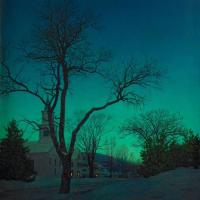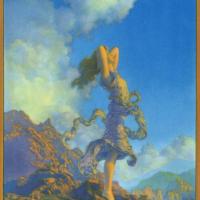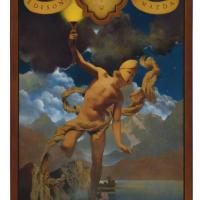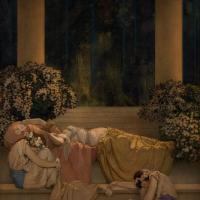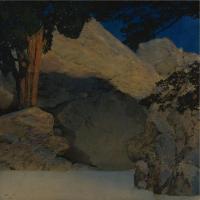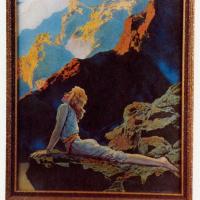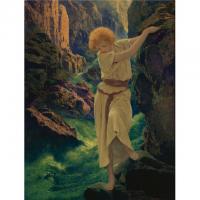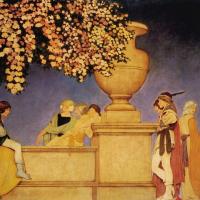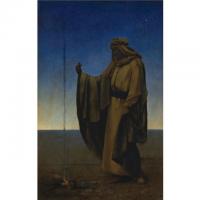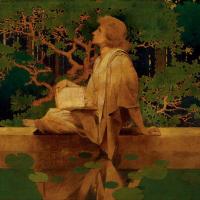Maxfield Parrish
At Close Of Day
$480.00
Daybreak
$480.00
Ecstasy
$480.00
Prometheus
$480.00
River Bank
$480.00
Shelter Oaks
$480.00
Sheltering Oaks
$480.00
Sleeping Beauty In The Wood
$480.00
The Canyon
$480.00
Two Cooks Peeling Potatoes
$480.00
Venetian Lamplighter
$480.00
Wise Man
$480.00
Youth By Reflecting Pool
$540.00
Maxfield Parrish
Maxfield Parrish (1870-1966)
Maxfield Parrish (July 25, 1870 – March 30, 1966) was an American painter and illustrator active in the first half of the 20th century. He is known for his distinctive saturated hues and idealized neo-classical imagery. His career spanned fifty years and was wildly successful: his painting Daybreak is the most popular art print of the 20th century.
Maxfield Parrish was born in Philadelphia, Pennsylvania, to painter and etcher Stephen Parrishand Elizabeth Bancroft. His given name was Frederick Parrish, but he later adopted Maxfield, his paternal grandmother's maiden name, as his middle, then finally as his professional name. He was raised in a Quakersociety. As a child he began drawing for his own amusement, showed talent, and his parents encouraged him. Between 1884 and 1886, his parents took Parrish to Europe, where he toured England, Italy, and France, was exposed to architecture and the paintings by the old masters, and studied at the Paris school of a Dr. Kornemann.
He attended the Haverford School and later studied architecture at Haverford College for two years beginning in 1888. To further his education in art, from 1892 to 1895 he studied at the Pennsylvania Academy of the Fine Arts under artists Robert Vonnoh and Thomas Pollock Anshutz. After graduating from the program, Parrish went to Annisquam, Massachusetts where he and his father shared a painting studio. A year later, with his father's encouragement, he attended the Drexel Institute of Art, Science & Industry.
Parrish entered into an artistic career that lasted for more than half a century, and which helped shape the Golden Age of illustration and American visual arts. During his career, he produced almost 900 pieces of art including calendars, greeting cards, and magazine covers. Parrish's early works were mostly in black and white.
In 1885, his work was on the Easter edition of Harper’s Bazaar. He also did work for other magazines like Scribner's Magazine. He also illustrated a children's book in 1897, Mother Goose in Prose written by L. Frank Baum. By 1900, Parrish was already a member of the Society of American Artists. In 1903, he traveled to Europe again to visit Italy.
Parrish took many commissions for commercial art until the 1920s. Parrish's commercial art included many prestigious projects, among which were Eugene Field's Poems of Childhood in 1904, and such traditional works as Arabian Nights in 1909. Books illustrated by Parrish are featured in A Wonder Book and Tanglewood Tales in 1910, The Golden Treasury of Songs and Lyrics in 1911, and The Knave of Hearts in 1925.
Parrish was earning over $100,000 per year by 1910, when homes could be bought for $2,000.
Parrish worked with popular magazines throughout the 1910s and 1920s, including Hearst's and Life. He also created advertising for companies like Wanamaker's, Edison-Mazda Lamps, Colgate and Oneida Cutlery. Parrish worked with Collier's from 1904 to 1913. He received a contract to deal with them exclusively for six years. He also painted advertisements for D.M. Ferry Seed Company in 1916 and 1923, which helped him gain recognition in the eye of the public. His most well-known art work is Daybreak which was produced in 1923. It features female figures in a landscape scene. The painting also has undertones of Parrish blue. In the 1920s, however, Parrish turned away from illustration and concentrated on painting.
In his forties, Parrish began working on large murals instead of just focusing on children's books. His works of art often featured androgynous nudes in fantastical settings. He made his living from posters and calendars featuring his works. Parrish used Kitty Owen as a model in the 1920s. Susan Lewin also posed for many works, and became Parrish's longtime assistant. From 1918 to 1934, Parrish worked on calendar illustrations for General Electric.
In 1931, Parrish declared to the Associated Press, "I'm done with girls on rocks", and opted instead to focus on landscapes. Though never as popular as his earlier works, he profited from them. He would often build scale models of the imaginary landscapes he wished to paint, using various lighting setups before deciding on a preferred view, which he would photograph as a basis for the painting (see for example, The Millpond). He lived in Plainfield, New Hampshire, near the Cornish Art Colony, and painted until he was 91 years old. He was also an avid machinist, and often referred to himself as "a mechanic who loved to paint". By 1935, Parrish exclusively painted landscapes.
Parrish's art is characterized by vibrant colors; the color Parrish blue was named after him. He achieved such luminous color through glazing. This process involves applying alternating bright layers of oil color separated by varnish over a base rendering. Parrish usually used a blue and white monochromatic underpainting.
Parrish used many other innovative techniques in his paintings. He would take pictures of models in black and white geometric prints and project the image onto his works. This technique allowed for his figures to be clothed in geometric patterns, while accurately representing distortion and draping. Parrish would also create his paintings by taking pictures, enlarging, or projecting objects. He would cut these images out and put them onto his canvas. He would later cover them with clear glaze. Parrish's technique gave his paintings a more three-dimensional feel.
The outer proportions and internal divisions of Parrish's compositions were carefully calculated in accordance with geometric principles such as root rectangles and the golden ratio. In this Parrish was influenced by Jay Hambidge's theory of Dynamic Symmetry.


